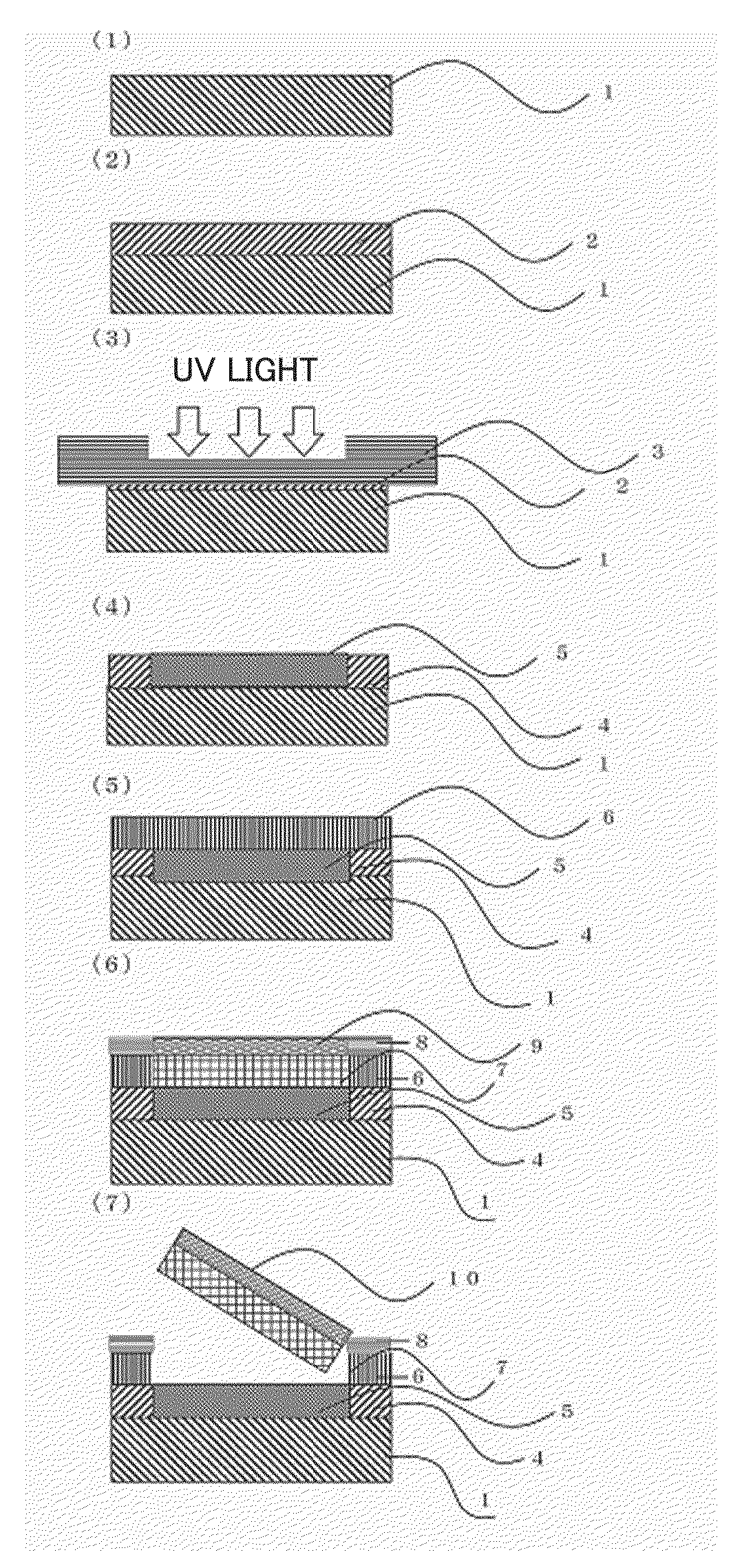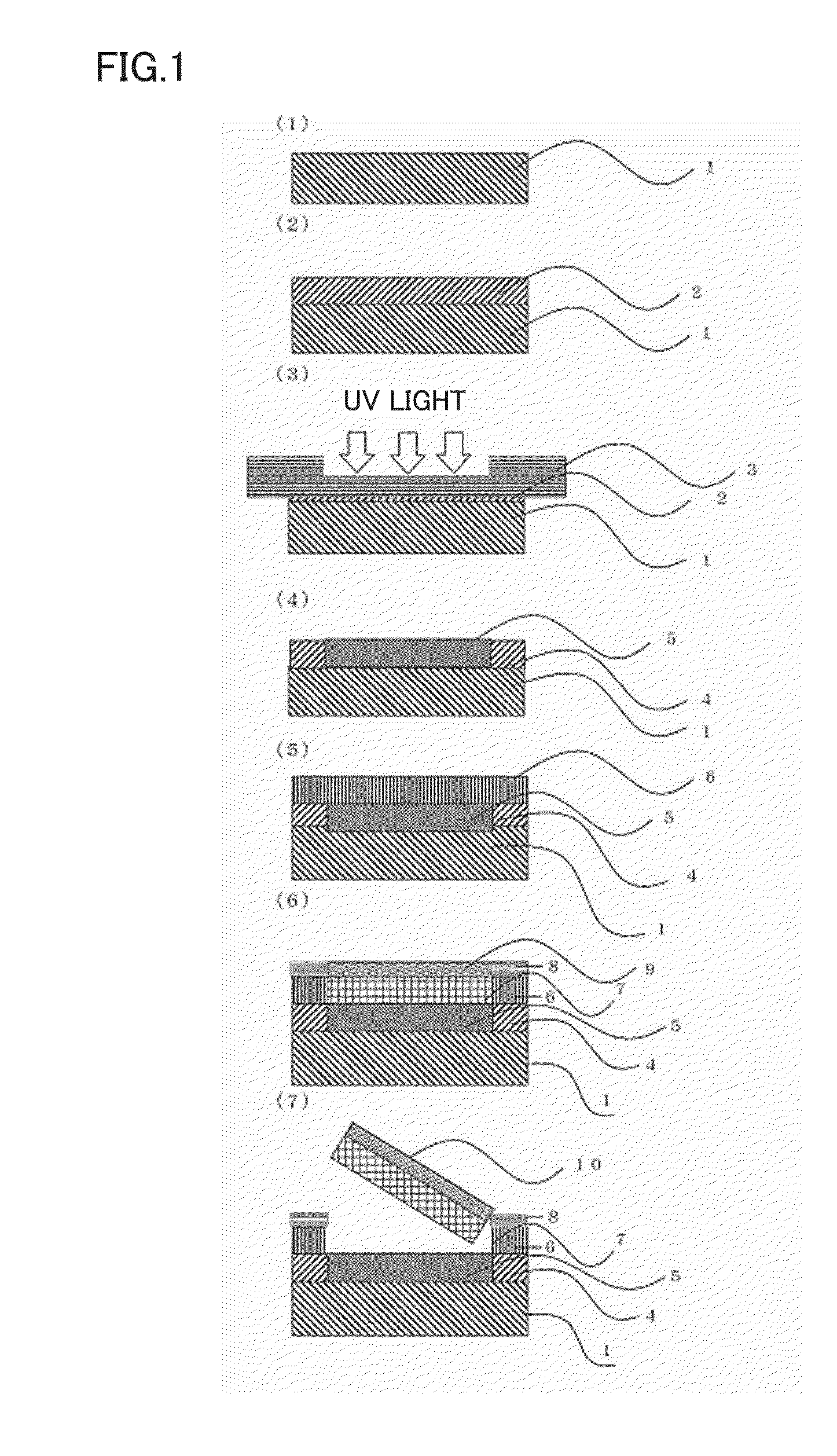Method for producing layered product, layered product, method for producing layered product with device using said layered product, and layered product with device
- Summary
- Abstract
- Description
- Claims
- Application Information
AI Technical Summary
Benefits of technology
Problems solved by technology
Method used
Image
Examples
examples
[0136]Hereinafter, the present invention will be described in more detail with reference to examples and comparative examples, but the present invention is not limited by the following examples. In this connection, the methods of evaluating physical properties in the following examples are as follows.
1. Reduced Viscosity of Polyamic Acid (ηsp / C)
[0137]A solution prepared by dissolving a polymer in N-methyl-2-pyrrolidone (or N,N-dimethylacetamide) so that the polymer concentration became 0.2 g / dl was measured at 30° C. with an Ubbelohde type viscosity tube (in the case where the solvent used for the preparation of the polyamic acid solution was N,N-dimethylacetamide, a polymer was dissolved in N,N-dimethylacetamide and the reduced viscosity was measured).
2. Solution Viscosity of Polyamic Acid Solution
[0138]The solution viscosity was measured at 25° C. with a Brookfield viscometer.
3. Thickness of Polyimide Film or the Like
[0139]The thickness was measured using a micrometer (available f...
production examples 1 to 3
Preparation of Polyamic Acid Solution A
[0174]After the inside of a reaction vessel equipped with a nitrogen inlet tube, a thermometer and a stirring rod was replaced with nitrogen, 223 parts by mass of 5-amino-2-(p-aminophenyl)benzoxazole and 4416 parts by mass of N,N-dimethylacetamide were added thereto and completely dissolved. Then, 217 parts by mass of pyromellitic acid dianhydride and SNOWTEX prepared by dispersing colloidal silica as a slip agent in dimethylacetamide (DMAC-ST30, available from Nissan Chemical Industries, Ltd.) in an amount that the silica content becomes the content described in Table 1 were added thereto. The liquid was stirred for 24 hours at a reaction temperature of 25° C., whereupon each of brown viscous polyamic acid solutions A1 to A3 was obtained. The measurement results are described in Table 1 and Table 2.
production examples 4 to 6
Preparation of Polyamic Acid Solution B
[0175]After the inside of a reaction vessel equipped with a nitrogen inlet tube, a thermometer and a stirring rod was replaced with nitrogen, 398 parts by mass of 3,3′,4,4′-biphenyltetracarboxylic acid dianhydride as a tetracarboxylic acid dianhydride and 147 parts by mass of paraphenylenediamine were dissolved in 4600 parts by mass of N,N-dimethylacetamide. The solution was subjected to a reaction in the same manner while the temperature was maintained at a temperature less than or equal to 20° C. to obtain each of polyamic acid solutions B1 to B3. The measurement results are described in Table 1 and Table 2.
PUM
| Property | Measurement | Unit |
|---|---|---|
| Peel strength | aaaaa | aaaaa |
Abstract
Description
Claims
Application Information
 Login to View More
Login to View More - R&D
- Intellectual Property
- Life Sciences
- Materials
- Tech Scout
- Unparalleled Data Quality
- Higher Quality Content
- 60% Fewer Hallucinations
Browse by: Latest US Patents, China's latest patents, Technical Efficacy Thesaurus, Application Domain, Technology Topic, Popular Technical Reports.
© 2025 PatSnap. All rights reserved.Legal|Privacy policy|Modern Slavery Act Transparency Statement|Sitemap|About US| Contact US: help@patsnap.com



